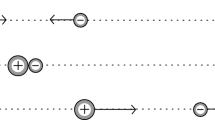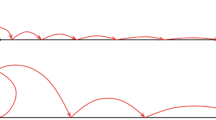Abstract
Billiard systems, broadly speaking, may be regarded as models of mechanical systems in which rigid parts interact through elastic impulsive (collision) forces. When it is desired or necessary to account for linear/angular momentum exchange in collisions involving a spherical body, a type of billiard system often referred to as no-slip has been used. In recent work, it has become apparent that no-slip billiards resemble nonholonomic mechanical systems in a number of ways. Based on an idea by Borisov, Kilin and Mamaev, we show that no-slip billiards very generally arise as limits of nonholonomic (rolling) systems, in a way that is akin to how ordinary billiards arise as limits of geodesic flows through a flattening of the Riemannian manifold.










Similar content being viewed by others
References
Arnold, V. I., Small Denominators and Problems of Stability of Motion in Classical and Celestial Mechanics, Russian Math. Surveys, 1963, vol. 18, no. 6, pp. 85–191; see also: Uspekhi Mat. Nauk, 1963, vol. 18, no. 6, pp. 91-192.
Dynamical Systems: VII. Integrable Systems Nonholonomic Dynamical Systems,V. I. Arnold, S. P. Novikov, Encyclopaedia Math. Sci., vol. 16, Berlin: Springer, 1994.
Bloch, A. M.,Ergodic Theory of Frame Flows Nonholonomic Mechanics and Control,Interdiscip. Appl. Math., vol. 24, New York: Springer, 2015.
Brin, M., Ergodic Theory of Frame Flows, in Ergodic Theory and Dynamical Systems: II (College Park, Md., 1979/1980), A. Katok (Ed.), Progr. Math., vol. 21, Boston, Mass.: Birkhäuser, 1982, pp. 163–183.
Brin, M. and Gromov, M., On the Ergodicity of Frame Flows, Invent. Math., 1980, vol. 60, no. 1, pp. 1–7.
Borisov, A. V., Kilin, A. A., and Mamaev, I. S., On the Model of Non-Holonomic Billiard, Regul. Chaotic Dyn., 2011, vol. 16, no. 6, pp. 653–662.
Borisov, A. V., Mamaev, I. S., and Kilin, A. A., Rolling of a Ball on a Surface: New Integrals and Hierarchy of Dynamics, Regul. Chaotic Dyn., 2002, vol. 7, no. 2, pp. 201–219.
Broomhead, D. S. and Gutkin, E., The Dynamics of Billiards with No-Slip Collisions, Phys. D, 1993, vol. 67, no. 1–3, pp. 188–197.
Chumley, T., Cook, S., Cox, C., and Feres, R., Rolling and No-Slip Bouncing in Cylinders, J. Geom. Mech., 2020, vol. 12, no. 1, pp. 53–84.
Cox, C. and Feres, R., No-Slip Billiards in Dimension Two, in Dynamical Systems, Ergodic Theory, and Probability: In Memory of Kolya Chernov, Contemp. Math., vol. 698, Providence, R.I.: AMS, 2017, pp. 91–110.
Cox, C., Feres, R., and Zhang, H.-K., Stability of Periodic Orbits in No-Slip Billiards, Nonlinearity, 2018, vol. 31, no. 10, pp. 4443–4471.
Cox, C. and Feres, R., Differential Geometry of Rigid Bodies Collisions and Non-Standard Billiards, Discrete Contin. Dyn. Syst., 2016, vol. 36, no. 11, pp. 6065–6099.
Garwin, R. L., Kinematics of an Ultraelastic Rough Ball, Am. J. Phys., 1969, vol. 37, no. 1, pp. 88–92.
Hefner, B. T., The Kinematics of a Superball Bouncing between Two Vertical Surfaces, Am. J. Phys., 2004, vol. 72, no. 7, pp. 875–883.
Kourganoff, M., Anosov Geodesic Flows, Billiards and Linkages, Comm. Math. Phys., 2016, vol. 344, no. 3, pp. 831–856.
Larralde, H., Leyvraz, F., and Mejía-Monasterio, C., Transport Properties of a Modified Lorentz Gas, J. Statist. Phys., 2003, vol. 113, no. 1–2, pp. 197–231.
Mejía-Monasterio, C., Larralde, H., and Leyvraz, F., Coupled Normal Heat and Matter Transport in a Simple Model System, Phys. Rev. Lett., 2001, vol. 86, no. 24, pp. 5417–5420.
Wojtkowski, M. P., The System of Two Spinning Disks in the Torus, Phys. D, 1994, vol. 71, no. 4, pp. 430–439.
Author information
Authors and Affiliations
Corresponding authors
Ethics declarations
The authors declare that they have no conflicts of interest.
Additional information
MSC2010
70F25
Rights and permissions
About this article
Cite this article
Cox, C., Feres, R. & Zhao, B. Rolling Systems and Their Billiard Limits. Regul. Chaot. Dyn. 26, 1–21 (2021). https://doi.org/10.1134/S1560354721010019
Received:
Revised:
Accepted:
Published:
Issue Date:
DOI: https://doi.org/10.1134/S1560354721010019




